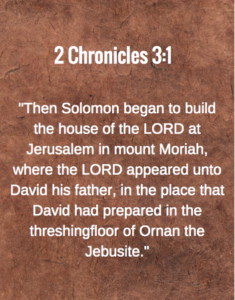The Biblical Case for the Location of the Temple: Part 1
 The Bible describes exactly where Solomon’s temple was built in 2 Chronicles 3:1
The Bible describes exactly where Solomon’s temple was built in 2 Chronicles 3:1
Then Solomon began to build the house of the LORD at Jerusalem in mount Moriah, where the LORD appeared unto David his father, in the place that David had prepared in the threshingfloor of Ornan the Jebusite.
However, if you don’t know the Old Testament, this won’t mean anything to you. I’m sure you would know where Jerusalem is, but do you know where Mount Moriah is? Do you know the story about David and Ornan the Jebusite? Do you know the relevant history regarding Jebus/Jerusalem from the book of Joshua?
From 2 Chronicles 3:1 we know that Solomon’s Temple was located IN Jerusalem. The book of Ezra also states this plainly in Ezra 1:2,3,5; 2:68; 6:5 among others, and 7:27. Mount Moriah (which is only named in 2 Chronicles 3:1 and in Genesis 22:2) is likely a mountain range, but won’t be essential to this study.
Since 2 Chronicles 3:1 specifically states that Solomon’s Temple was located in Jerusalem, and the Temple was to be built upon the threshing floor of Ornan the Jebusite, we know that the threshingfloor of Ornan the Jebusite must be in a specific spot within the city of Jerusalem.
Jerusalem at the time of David covered a very small area so the threshingfloor must have been located within that specific geographical area. Currently, the city of Jerusalem covers a much larger area. It is important not to commit the fallacy of superimposing what you see today over what existed at the specific time we are looking at. Even the topography of the land was significantly different at that time.
The story of David and the threshingfloor of Ornan the Jebusite is given in 1 Chronicles 21:18-30. Following the instructions that God commanded Gad to give him, David went to Ornan the Jebusite to build an altar to the LORD. Ornan wanted to give it to David, but David insisted on purchasing it. David built the altar there on the threshing floor. He could not offer sacrifices at the normal place, which was the altar of the burnt-offering in the tabernacle of the LORD located in “the high place at Gibeon” because he was afraid of the sword of the Angel of the Lord.
So three main facts have been established:
1. The Temple of Solomon was built within the geographical area covered by the city of Jerusalem at the time of David. It had to be within that area, or it would not have been in Jerusalem as is specifically stated.
2. The Temple was built on the threshingfloor of Ornan the Jebusite
3. The threshingfloor of Ornan the Jebusite was within the geographical area covered by the city of Jerusalem at the time of David. It could not have been outside the city of Jerusalem.
This may seem elementary, but it is important to keep these facts in mind at all times because the geographical area covered by the city of Jerusalem is essential to pinpointing the location of Solomon’s temple, and those that were built thereafter.
Jerusalem is the City of David
Jerusalem was originally occupied by the Jebusites—it was sometimes called Jebus, but was called Jerusalem a number of times. This is made clear by several verses—Joshua 15:8,63; 18:28; Judges 1:21; 19:10 and also 2 Samuel 5:6 which states:
And the king and his men went to Jerusalem unto the Jebusites, the inhabitants of the land: which spake unto David, saying, Except thou take away the blind and the lame, thou shalt not come in hither: thinking, David cannot come in hither.
But David “took the strong hold of Zion” i.e. the fortress (v7) by going up a watershaft from the Gihon Spring. David then lived in the fortress and called it “The City of David.” (v9). The Israelites could not drive the Jebusites out, so they lived with them until at least the time of the writing of Joshua and Judges. [Joshua 15:63 and Judges 1:21].
This event occurred sometime before David purchased the threshingfield from Ornan the Jebusite which was discussed earlier. So the geographical parcel of land which was Jerusalem at that time was also the exact location of the city of David because they were synonymous.
According to most any reference material out there, the Jebusite city called Jerusalem and also called the City of David, was a relatively small parcel of land, and the borders seem to be agreed upon by most of them. You can see an example map here: Map of Jebus or Jerusalem. [Look at the third image from the top]
[Warning: Do not take the labeling on any map of the Jerusalem area for granted. Many of the labels are wrong, which will be shown in a future post. However, the basic geographical borders of the Jebusite City/The City of David is virtually identical on most maps.]
So now we know that Solomon’s temple had to be built within the City of Jerusalem/City of David specifically in the spot where Ornan the Jebusite’s threshingfloor was at the time of David. Any area outside of that place cannot be the location of any future temple either. The temple cannot be outside of the geographical area occupied by Jerusalem/City of David at the time of David.
The current area called “The Temple Mount” is OUTSIDE of that geographical area, so the temple could not have been located anywhere on it, unless you go against scripture.
[As always, I welcome comments and questions on this topic. Please keep them short and concise.]
Next: The Biblical Case for the Location of the Temple Part 2